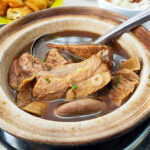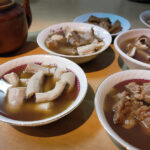Bak Kut Teh: The Most Iconic Hearty Dish from Klang
Bak Kut Teh 肉骨茶, a dish closely associated with Klang in Malaysia, is an iconic and beloved culinary delight. The name Bak Kut Teh originates from the Hokkien language, translating to “meat bone tea”. While it may sound like a tea-based dish, it is actually a meat dish consisting of pork ribs stewed in a flavourful broth infused with a blend of fragrant herbs and spices.
The origins of Bak Kut Teh have various speculations, but it is widely believed that the dish was introduced by Hokkien immigrants from Fujian province in China during the 19th and early 20th centuries. During this period, British Malaya required an influx of inexpensive labourers for its plantations, mines, and ports. Many Hokkiens from the Quanzhou region settled in Port Swettenham, now known as Klang, where they worked as labourers.
The labourers faced harsh conditions, often suffering from muscle pain, fatigue, and other ailments. To rejuvenate themselves and boost their immune systems, they started consuming a traditional Chinese herbal concoction made from discarded or inexpensive pork bones commonly available in Klang. Drawing inspiration from Quanzhou’s traditional herbal beef ribs dish, Niu Pai, the unique Malaysian Bak Kut Teh was born.
In Malaysia, Bak Kut Teh is renowned for its robust and aromatic herbal broth. The broth is seasoned with soy sauce, garlic, star anise, fennel seeds, and up to 30 types of Chinese traditional herbs, including Solomon’s Seal (Yuzhu), Codonopsis root (Dangshen), Angelica root (Danggui), and Cassia bark (Guipi), among others. Achieving the familiar taste of Bak Kut Teh requires skill and experience in carefully balancing these ingredients.
Over time, Bak Kut Teh has evolved into a complete meal. It is commonly enjoyed with a bowl of rice and accompanied by side dishes such as youtiao/cakoi (Chinese doughnut), tofu puffs, mushrooms, preserved vegetables, braised eggs, pork offals, and more. A dipping sauce made from dark soy sauce, fresh minced garlic, and sliced chillies complements the dish. Traditional Chinese tea is often served alongside Bak Kut Teh, believed to help balance and cleanse the richness of the dish.
As Bak Kut Teh gained popularity in Malaysia, different communities developed their own versions. Teochew-style Bak Kut Teh typically features a clear broth with a lighter flavour, seasoned with garlic, soy sauce, and pepper. Cantonese-style Bak Kut Teh has a less intense colour and saltiness, focusing more on herbal flavours. Additionally, non-pork variants have emerged, substituting the meat with chicken, duck, beef, mutton, seafood, catering to the Muslim community. There are also vegetable-only alternatives available for vegetarians in Malaysia.
Bak Kut Teh has become a beloved meal among the Chinese community in Malaysia. It is enjoyed throughout the day, available for breakfast, lunch, dinner, and even supper. In Klang alone, there are hundreds of restaurants and stalls serving authentic and delicious Bak Kut Teh. For home cooks seeking convenience, prepacked sachets of Bak Kut Teh herbs are available. This dish has also spread to other Southeast Asian countries, including Thailand, Singapore, and Indonesia.





